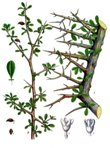Myrrh
Commiphora myrrha
In the bible, Myrrh was described as one of the most popular and precious resins. It was an ingredient used in holy ointments, perfumes, medicines, and it was used by the ancient Egyptians as incense in their temples. Also in the scriptures, Myrrh (along with Frankincense and gold)was one of the three precious gifts offered to Baby Jesus by the wise men. Vinum murratum, a wine containing myrrh , was offered to Jesus before being crucified. One more biblical reference of Myrrh was when Nicodemus brought a mixture of Myrrh and aloes to wrap the body of Jesus in after he was crucified.
Myrrh is produced when the bark of a plant from the Commiphora species is pierced, and a thick white gum appears. When the gum is air dried, it forms irregular, round lumps ranging in color from brown/black to light orange/brown.

As previously mentioned, the sources of myrrh are various Commiphora species. However, the specific species of Commiphora that gives rise to Myrrh is debatable. Some species that have been known to produce Myrrh include Commiphora myrrha, Commiphora molmmol, Commiphora madagascariensis, and Commiphora erythraea. These shrubs/small trees have large, pointy thorns on the stems and Myrrh is produced via the resin ducts when the plant is damaged. To learn more about how incisions are made in the plant and resin is collected to produce Myrrh, check out the Uses/Interesting Facts page.
.jpg)